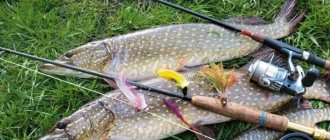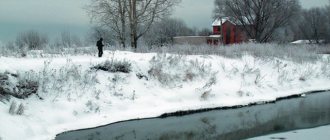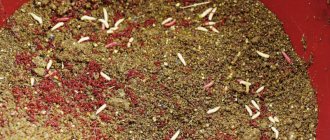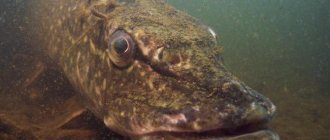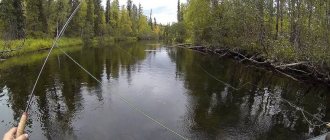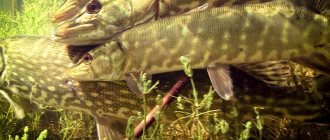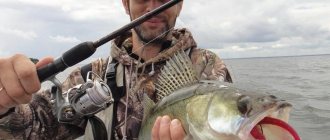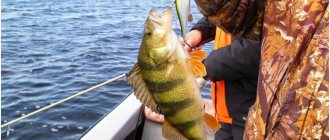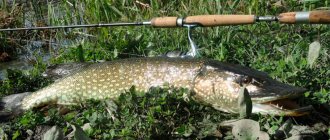Fishing for pike is possible all year round, but the volume of the catch and biting activity may vary in different quarters. The entire biting period can be divided into several parts. The first period occurs at the beginning of spring after the ice melts and lasts approximately 2-3 weeks. After wintering, she hunts especially actively.
In early April, during spawning, up to two weeks, active and aggressive behavior predominates in pike. This is due to abundant eating. In the summer, she is inactive and extremely calm. Therefore, it is better to catch it early in the morning. During the period from the second half of September to the end of November, activity increases significantly. This is due to the intense gluttony before the start of winter. In winter, the fish behave very confidently and willingly bite mainly on live bait.
What does biting depend on?
The intensity of the bite directly depends on various external factors. Even relying on the many years of experience of professional fishermen, it is impossible to say with 100% certainty when a predator will willingly bite. But you can make a forecast, taking into account the following:
- The influence of the phases of the moon. The most suitable fishing period is 1-7 days of the new lunar month and 17-21 days. The beginning of the lunar month falls on the new moon phase (absence of the moon in the sky).
- Atmospheric components. Magnetic storms greatly affect fish activity. Unlike a person, she senses the onset of a storm 2-3 days before its arrival. In this regard, the intensity of the predator increases before the onset of this phenomenon so that she does not starve. A sharp jump in temperature followed by a long-term cold snap and rapid warming. A decrease in atmospheric pressure before a thunderstorm negatively affects the fish bite.
- Daily mobility. The first peak of activity occurs in the early morning, 1.5-2 hours before sunrise. The second peak is after 15:00 and before sunset. At night, pike also behave quite aggressively, which allows you to get a good catch.
Pike in autumn, 5 secrets
The article talks about what you need to know in order for pike fishing in the fall to always be effective. There are 5 secrets!
At the end of October and beginning of November the first frosts occur. During this period, the water cools down very much, as a result of which the underwater vegetation freezes and lies in an even layer on the bottom of the reservoir, thereby opening up new areas for the angler to catch toothy predators. Many professional spinning anglers are looking forward to this gift of nature with great impatience, since they can begin to explore those areas that could not be fished throughout the summer due to underwater vegetation.
Let us note that other amateur fishermen who are accustomed to fishing with donks and float rods also try not to miss this moment. They put their usual gear aside and, armed with a spinning rod, go to small bays in search of perch and pike.
But not everyone is destined to return with a large and rich catch even during this period of time. There are several explanations for this.
Secret one
Pike really don't like sudden changes in temperature. Fish, as everyone knows, are cold-blooded, and due to a decrease in temperature, biological processes in its body immediately slow down, as a result of which its activity is significantly reduced.
During the cold season, pike are least active. Its main task, even during a hunt, is to spend as little effort and energy as possible. During the cold season, pike most of the time stands motionless in one place, waiting for the fry to swim by. Note that the size of the fry must be large so that the effort to jerk at the moment of attack is not wasted. In autumn, shallow lakes and eriks cool down at a rapid rate, as a result of which pike activity becomes dull. Based on this, it should be concluded that autumn pike in cold water should be looked for only in small areas and the coastal zone. In addition, it is important to correctly approach the issue related to the choice of artificial baits for pike fishing.
As practice shows, autumn pike begin to be caught best in the afternoon, this is worth remembering.
The second secret
Of course, the weather has a great influence on pike activity, to a greater extent this concerns illumination and atmospheric pressure. As it may seem, in calm sunny weather the pike should be most active, since the water warms up faster and the conditions in the reservoir become more favorable. However, this is not the case. Pike are most active in cloudy and rainy weather. This is explained by the fact that in autumn the degree of water transparency is quite high, and this negatively affects the comfort of pike. Therefore, in sunny weather, the predator tries to hide from the sun as quickly as possible and least of all thinks about hunting. It is also important to note that in sunny weather the atmospheric pressure is always high, which has a very negative effect on the activity of the predator. As for cloudy weather, the pressure is almost always low and, most importantly, stable, which in turn increases the degree of activity of the pike. In addition to these natural factors, the wind affects the pike bite. On days when there is no wind, the pike becomes more cautious and tries not to leave its ambush over trifles. However, the wind that blows from the east or north also has a negative effect on the bite. The best wind for pike fishing is one blowing from the southwest or south at a speed of no more than 7 m/s.
How do you know what the weather will be like? – The article contains several ways to determine what the weather will be like the next day (or during the day).
Many anglers try to go fishing in sunny and calm weather, but in rainy weather they don’t even think about fishing and this is their biggest mistake. It is impossible to compare comfort for humans and comfort for fish, since these things are completely opposite, that is, what is good for humans is bad for fish.
The third secret
It is important to pay attention to the phase of the moon. There is an opinion that it does not affect the activity of pike, but this is not the correct opinion. We can say with confidence that the latter and the first contribute to an increase in fish activity.
The fourth secret
Correct choice of artificial bait. It is difficult to determine with confidence which bait will catch pike best, since this is influenced by many factors, such as the characteristics and conditions of the reservoir, time of day, weather conditions, and the fry that the pike feeds on in the reservoir. Therefore, when going to a pond, you need to have in your kit the largest possible range of artificial baits. It is believed that spinners and wobblers are the most catchy, but this does not mean that spinners and silicone can be put aside. The support of baits must be carried out taking into account the fishing location. As we have already said, in the fall pike prefers to stay shallow, and therefore the bait should be light. However, in no case should it be small, as this can lead to the fact that it will be most attacked by perch, and not by pike, which is the main target of fishing. To catch pike in the autumn, it is recommended to use baits the size of which is at least 12 cm. In addition, it is necessary to select baits that are capable of performing a good game even at a minimum fishing speed. As for the color, it doesn't matter much.
Secret fifth
Change the location as often as possible while fishing. You shouldn’t focus on one area, because if after 10-15 throws there is no pike attack, this can only mean that it is not there. By frequently changing your fishing location, there is a high probability that you will be ambushed by a pike.
Bite at different times of the year
Depending on the time of year, the pike's biting activity also changes.
Spring. The time of year is characterized by a very high intensity of bites. But it’s different every month:
- March. Ideal month for fishing. Pike forgets about caution and rushes to almost any bait: spinners, wobblers, twisters, live bait, ratlins, blanks, cicadas, large uralks, etc.
- April. The rivers begin to flood and the water becomes very muddy. For fishing, it is better to use noise baits: petal jigs, actively playing noise wobblers, etc.
- May. Rising temperatures and the growth of small fish force the predator to hunt. Well suited for fishing: wobblers with active play, spinners.
Summer. Despite the hot and sultry weather, fishing is also possible.
- June. Stable pike fishing lasts until the middle of the month, then fish activity decreases. The fish begins to hide in the algae and go deeper. Oscillating spoons measuring 5-7 cm are good for fishing in June.
- July. The month with the highest temperature and algae counts. At optimal temperatures, pike of any size bite relatively well. When the water temperature rises, a large predator stops hunting. It is recommended to use large baits.
- August. With a decrease in temperature and an increase in pike activity, the fishing season begins. Suitable for all types and sizes of gear.
Autumn. The most profitable period of the year for pike fishing. An intense and more stable diet begins before wintering .
- September. The beginning of the season for catching large specimens of this fish species. When fishing from the shore near the grass, small spoons and wobblers work well. When fishing from a boat at depth, it is recommended to use jig baits.
- October. An ideal month for spinning fishing. The predator attacks everything that glitters. At this time, it is better to fish with large-sized gear 10-12 cm: wobblers, spoons, various spoons.
- November. The month for catching the largest specimens. It is better to “hunt” for pike in the early morning. To replenish your collection with new trophies, you should use vibrating tails, spinner spoons, and balancers (except for silver ones).
Winter. During the cold season, this fish does not hibernate, but its mobility is significantly reduced.
- December. When fishing on the first ice, balancers, spoons and jigs are well suited. In regions where there is still clean water, jig baits can be used.
- January. This month is considered to be a “deaf” time for fishing. Pike are very lazy in January, but a small catch is possible. It is preferable to use girders.
- February. Time of start of fish mobility. It works well on blanks and spoons with a worm or pieces of fish.
Mighty Fishing Stereotypes
There are many different stories and instructive articles on the Internet about pike fishing in the fall. In each you can find a huge amount of useful information collected by spinners over many years of fishing. You can’t not believe them, but you can’t treat them as dogma either. Don’t blindly try to copy and apply someone else’s practice to yourself.
What will be written below are just my observations on specific fishing spots in September 2021.
Bait size
They say that the autumn pike zhor is the time when the spotted beauty without hesitation attacks any bait that comes into view. Who knows, maybe there are such reservoirs, but, apparently, the Angara bays and the nearest lakes are not one of them.
The local pike does not like to chase everything that falls into the water. Each trip to the river and the Boguchanskoe reservoir requires the presence in the fishing box of an arsenal that is quite extensive in terms of characteristics. Looking ahead, I’ll say that after the last time I started thinking about purchasing a jerk spinning rod.
I'm a fishing enthusiast just like you. I constantly read published publications. I wonder what people use to catch pike today. So, the rule that in the fall the pike tries to bypass the summer “small things” (4-6 centimeter wobblers and spinners “zero”, “one” and “two”) has never been confirmed.
From time to time it happens that you spend half a day rinsing large wobblers and spinners, tapping the entire bottom with 10-15 centimeter silicone. And there is a big pike. And she eats. This can be seen from the splashes and breakers on the surface. You take a spinning rod up to 16 grams in your hands, put on a medium-sized spinner without weight Meps Lusox No. 2, in the hope of chasing a perch - a couple of wires and the “three-three” lands. A dozen more casts in different directions - a couple of tails in addition. And this is at a depth of 4-5 meters.
As an alternative to the classic spoon, you can use a cicada.
I agree that at the end of summer, when aquatic vegetation dies off, transparency in local lakes and for the most part along the shoreline of the reservoir is reduced to a minimum, I prefer to fish with “Pinocchio” 120-140 mm. Not necessarily acid colored. The color preference of pike is selected on a case-by-case basis. But large baits make it possible to effectively pull both “mothers” and beetles ashore. Small wobblers are actually not in demand.
As the weather gets colder, the haze disappears. The concentration of oxygen dissolved in water increases. Visibility increases significantly. According to my observations, pike in the fall (or in September) are not particularly selective in the size of spinners and wobblers. I can’t say that with silicone. I “train” my hand mainly on bulk “iron” and “plastic”.
Shallow or deep
Shallow bay. Background depth 1.5 meters. Then there is a sharp drop of 7-8 meters. My friend and I get up on the boat and begin to process baits of suitable sizes. Rare bites of laces and that's it. Not even anyone at the dump.
In the stern of the boat there is a powerful cartoon tackle with some kind of Chinese jerk. I ask permission to try my luck and send the “cutlet” sailing. Five wires to get used to the gear. Cast towards the shore. Powerful grip. In appearance, the pike is worth ten. It’s a pity that the camera from the fishing gear went to Neptune. It seems that they are no longer beginners, but who could have expected such a beauty 4 meters from the shore at a depth of 1-1.5.
And this is another refutation of the fact that with cold weather, the pike goes deeper into the depths following the fry. I had to catch the predator on frosty days along the banks using slowly rising wobblers. The pike did not bite on weakly sinking ones. So it turns out that even the direction of the ascent movement makes sense.
The characteristics of the honeypot matter more than the faulty algorithm.
Wiring
I’ll keep silent about the “best” and “correct” wiring. She doesn't exist. The fisherman is required to know the performance characteristics of a wobbler or spinner, their capabilities and further selection of animation, based on knowledge, for specific cases.
I recently read an interesting article about pike fishing somewhere in the Kemerovo region. The man wrote what he had an idea about firsthand. Nice post. But one remark seemed wrong to me.
The point is that the choice of wobbler wiring depends on the depth of the area of the reservoir where fishing is done. If it’s shallow, then you should perform the animation in small steps, “dying” twitching (if you remember Alexey Shanin), if it’s deep, then the rapid movement of the bait makes the pike rush.
I fundamentally disagree with this statement. There have been numerous cases when fishing for pike, when it was the fast, monotonous retrieval of the hardcore “zero” that forced the predator to react. At the same time, playing on the spot in close proximity to the fish had no effect.
The same goes for fishing in deep areas. I prefer suspenders with minimal positive or negative buoyancy, since keeping the wobbler at a depth in one place and leisurely movements most often become the key to success.
Conditions for the best bite
Pike is a fastidious fish, and if you choose the wrong time for fishing, you risk being left without a catch. The most optimal conditions for fishing:
- Times of Day. Fishing should begin 1.5 hours before sunrise and after lunch closer to sunset. During these periods she is most active.
- Weather. The optimal weather for “hunting” is cloudy, light rain, and light wind.
- Pressure. Pike, like all other fish, is weather dependent. Low blood pressure is considered favorable for her.
- Temperature . This predatory fish does not like high or too low temperatures. For the spring-autumn period of the year, the most favorable water temperature is from +8°C to +25°C. The optimal temperature for winter fishing is down to -15°C (air temperature).
- Place for fishing. Small and medium-sized specimens mainly stay near the shore in snags and overgrown with reeds or algae. Favorite places also include areas near dams and rifts.
Large fish, on the contrary, give their preference to greater depths. Most importantly, any pike cannot tolerate “low-oxygen” reservoirs: silty, shallow rivers and lakes.
Where, when and what bait to use
The main baits are: spinners, wobblers and live bait. But they also have many varieties:
- Spinner "oscillators" . The favorite bait itself, which meets all the physiological needs of the predator. Eppinger Daredevle Spoon is the best choice of classic spoons for catching large trophies. Suitable for fishing in clean and deep waters during every hunting season.
- Spinner "spinners" . Suitable for catching active fish. Spinner: Blue Fox Super Bou, Mepps H210 and Mepps Double Blade Aglia are the most effective among the wide range of spinners. Used for fishing during peak periods of fish activity. Can be used both at shallow and large depths.
- Spinnerbait. The bait is well suited for both passive fishing and for increased intensity during feeding. Due to its design, it has a good effect on many of the fish's senses and makes them rush to the bait.
- Wobblers. There are three types of baits of this type: pop-up, suspended (kept at medium depth without guidance), and sinking. The most loved by pike are Minnow wobblers. For small fish it is recommended to take bait up to 8 cm long, and for large trophies up to 13 cm. Well suited for passive fish.
- Vibrotail, twister. Due to its small size and huge range of colors, it is in high demand when fishing from great depths. This bait is ideal for hunting in the spring and autumn periods of the year.
The main methods of spinning fishing and the baits used
Spinning pike fishing can be divided into two parts. This is fishing in the cold season, with water temperatures up to + 15 degrees Celsius. And during a period that is more comfortable for humans, but not for pike, when the water temperature is above + 15 degrees. In cold water, the predator is more active and can take all spinning baits, but it is best to catch it with a jig. The best jig baits are vibrating tails with a weight on a ball-shaped head. The toothy robber will not miss the bait moving by jumping along the bottom. Also, the serrated one will not refuse a deep-sea spoon with a wide amplitude game.
When the water gets warmer, the pike's behavior changes. Most fry, different types of fish, rush to bask in the warm, upper layers of water. And although pike does not feel comfortable in warm water, the abundance and ease of prey force it to rise from the depths, closer to the upper layers of the water. During this period, it is spotted and takes well on a wobbler with a slight depth. During this period, pike often bite on turntables with a lively petal standing in front of the load.
With further warming of the water, the pike bite weakens significantly. Catching a toothy robber at this time is a rare occurrence. She now fishes best on surface wobblers and poppers. In the summer, when you rip open the belly of a caught pike, you can find a perch with a fry in its mouth. The game of a popper is very reminiscent of a perch hunting for fish fry, and perch, as you know, is a favorite treat for pike. Therefore, popper in summer is the best artificial bait for toothy predators.
If it doesn't bite
There may be several reasons for the lack of bite. Pike fish are quite capricious and can easily ignore any bait, from a bright wobbler to the fattest live bait. The reason may be the following:
- Wrong time. Fishing in the middle of winter, when she prefers secluded places, or in the spring immediately after spawning, when she has exhausted all her strength for future offspring, is immediately doomed to failure. Do not forget that pike cannot tolerate summer heat of +40°C.
- Fishing place . This type of fish prefers secluded habitats. It is not recommended to catch it in open water. If it happens that the place seems suitable, there are snags and thickets, but there is no bite, perhaps there is simply no predator here.
- Bait . If there is no bite on a vibrotail, twister or spinner, perhaps they look too artificial for the pike. Try simply changing the type of bait.
Finding pike fishing spots
In spring, you should look for pike in the grass, in shallow waters, where small fish come out to bask. The predator chooses places for ambush that would camouflage it and also serve as an observation post. If live bait comes into the field of view of a toothy fish, it will go on the attack, so catching pike with live bait in the spring is especially important in grass thickets or at a short distance from them.
In lakes, you can look for pike near snags and flooded bushes, at the confluence of rivers and streams, and at changes in depth. On the river, pike’s favorite places are whirlpools, entrances and exits from holes, oxbow lakes, washed-out banks, and channel edges.
In summer, pike fishing with live bait occurs throughout the entire reservoir. Pike ambush sites are stranded holes, snags, and furrows. With a thermocline, it is also important to determine the horizon in which the fish is located. Live bait will help with this; in a favorable environment it will be active and playful.
On the river, you need to look for pike in places where the shallows transition to depth, and the predator stands immediately under the dump or at the very edge of the dump. Where the current is weaker, the whitebait stays there, and this is where you need to catch pike. Pike often bite on live bait on cliffs, windbreaks, and in reverse currents.
Flaws
Recommendations for successful biting
Time:
- cloudy weather, weak wind, low pressure;
- choose periods of highest fish activity;
- time of day: early morning and late evening.
Lures:
- natural color;
- low-frequency range of motion;
- large.
Place:
- reservoirs with sufficient oxygen content;
- secluded places: overgrown with grass, with snags;
- Large fish mainly stay at depth.
